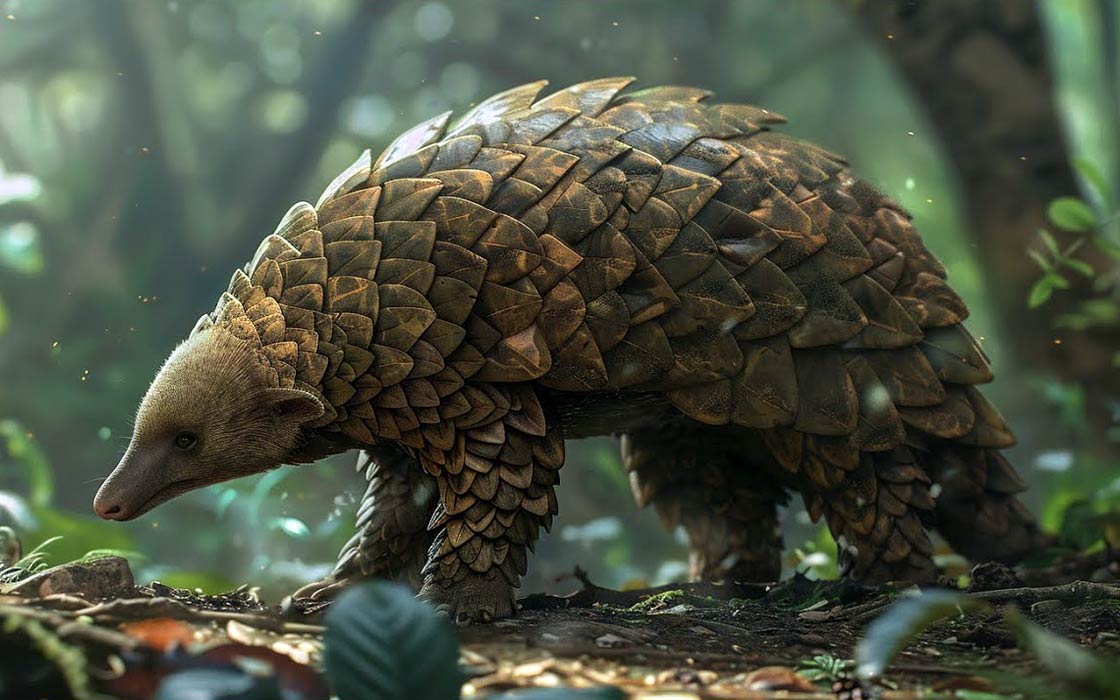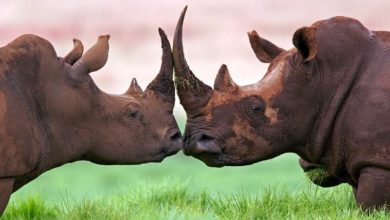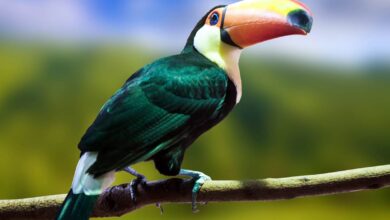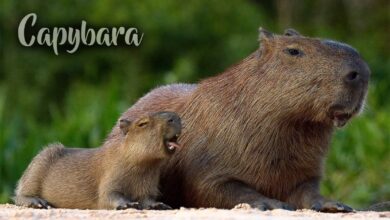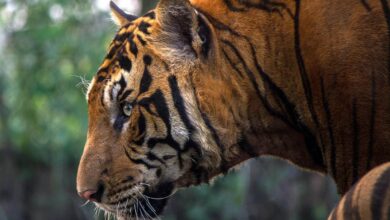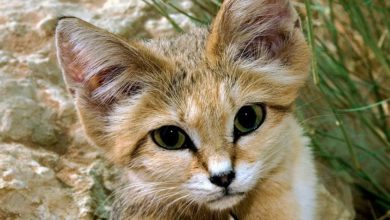Pangolins
Despite its rather small size, this peculiar mammal effectively defends itself against Asian predators such as the tiger. This peculiar creature, often mistaken for a reptile due to its unique, armor-like scales, possesses remarkable adaptations that allow it to hold its own in a world teeming with danger. Although not as feisty as the honey badger or wolverine, it can emerge unharmed from a dangerous confrontation. Its unpretentious appearance belies a suite of extraordinary defenses and behaviors that make it a true survivor in the wild. If you don’t know how this unassuming animal manages in the ruthless world of Asian killers, look at its photo. Facts about the pangolin’s life, contained in the article below, will complete your knowledge and show that even a small, gentle mammal can successfully live in a wild, danger-filled ecosystem.
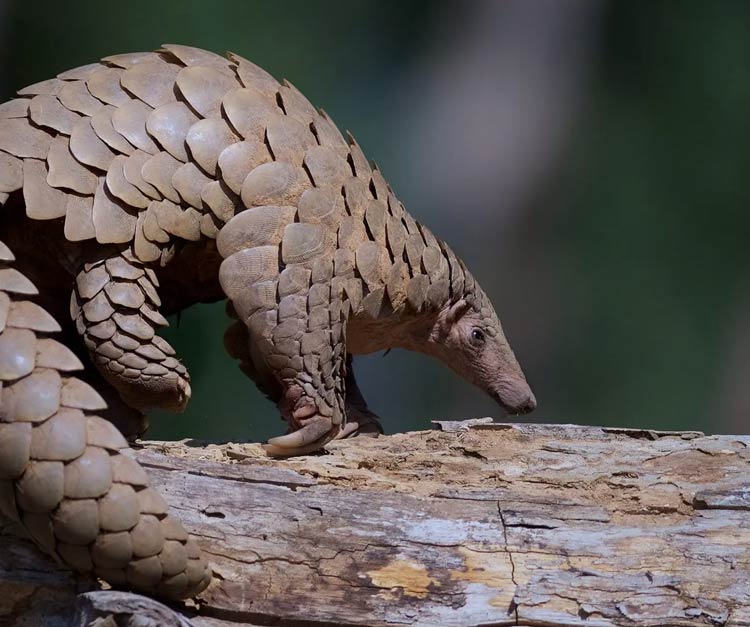
Classification
- Class: Mammals
- Order: Pholidota
- Family: Manidae
- Genus: Manis
- Species: Indian Pangolin, thick-tailed pangolin (Manis crassicaudata)
The Indian Pangolin belongs to the family Manidae. The family Manidae is also sometimes referred to as pangolins. Pangolins inhabit two continents – Asia and Africa. There are three genera in this family: Manis, Phataginus, Smutsia.
| Taxonomic Rank | Manis (Asiatic pangolins) | Phataginus (African tree pangolins) | Smutsia (African ground pangolins) |
|---|---|---|---|
| Kingdom | Animalia | Animalia | Animalia |
| Phylum | Chordata | Chordata | Chordata |
| Class | Mammalia | Mammalia | Mammalia |
| Order | Pholidota | Pholidota | Pholidota |
| Family | Manidae | Manidae | Manidae |
| Subfamily | Maninae | Phatagininae | Smutsiinae |
| Genus | Manis | Phataginus | Smutsia |
| Common Traits | Asiatic pangolins, mostly arboreal or terrestrial | African arboreal pangolins | African terrestrial (ground) pangolins, larger size |
The entire family includes three genera and 8 species
Asian pangolin species (genus Manis)
- Chinese pangolin (Manis pentadactyla) – Critically Endangered
- Sunda pangolin / Malayan or Javan pangolin (Manis javanica) – Critically Endangered
- Philippine pangolin / Palawan pangolin / balintong (Manis culionensis) – Critically Endangered
- Indian pangolin / thick-tailed pangolin / scaly anteater (Manis crassicaudata) – Endangered
African pangolin species (genus Phataginus and Smutsia )
- White-bellied pangolin / tree pangolin / three-cusped pangolin (Phataginus tricuspis) – Endangered
- Long-tailed pangolin / African Black-bellied pangolin / ipi (Phataginus tetradactyla) – Vulnerable
- Giant pangolin (Smutsia gigantea) – Endangered
- Ground pangolin / Temminck’s pangolin / Cape pangolin / steppe pangolin (Smutsia temminckii) – Vulnerable
In today’s article, we will focus our attention on the Indian Pangolin (thick-tailed pangolin).

Indian Pangolin, thick-tailed pangolin (Manis crassicaudata)
The Indian Pangolin lives in areas of India, Nepal, Sri Lanka, and Pakistan. It occupies diverse habitats, including tropical forests, plains, and low mountain slopes. However, it can also be found in grasslands, secondary forests, and even desert areas. Sometimes it ventures onto high peaks, reaching up to 2,300 m (7,546 ft) above sea level. However, it prefers areas covered with soft soil where it can dig burrows.
Unlike its African relative, the Indian Pangolin does not live in trees, but readily digs burrows close to bushes and trees. Insects are the primary element of its diet.
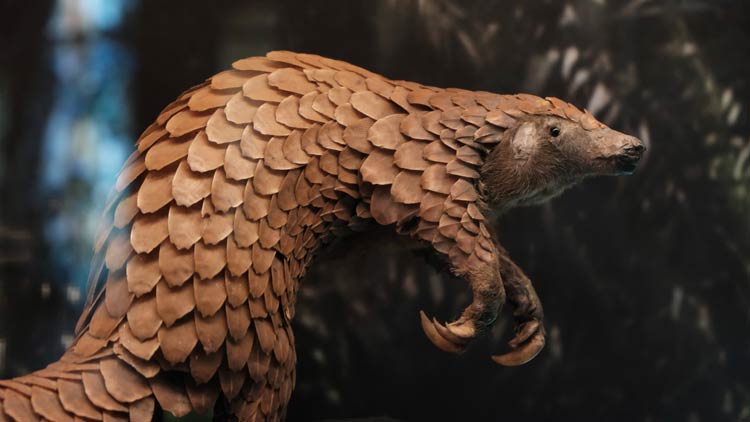
Characteristics
Appearance
Body length ranges from 45-75 cm (17.7-29.5 in), while the tail itself can measure 33-45 cm (13.0-17.7 in). Weight is usually 10-16 kg (22.0-35.3 lb). Males are generally larger than females, hence sexual dimorphism is observed within the species.
The head is small and triangular in shape, while the body is slender and elongated.
On each paw there are 5 powerful claws, of which 3 are adapted for digging burrows or finding the nests of their prey. However, this animal does not have teeth, so the main organ enabling it to eat is a sticky tongue measuring 23-25.5 cm (9.1-10.0 in) in length (in this regard, it resembles anteaters and tamanduas). Strong stomach muscles also help it in digestion.
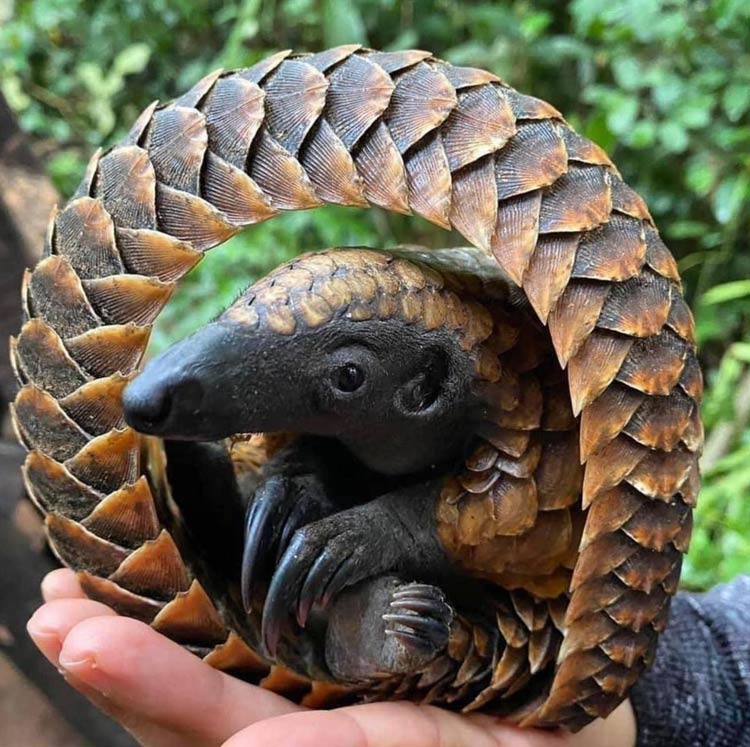
Armor
Scales
The pangolin’s back and head are covered by 15-18 rows of hard scales, while on the tail there are 14-15 rows. They are brownish-yellow or grayish-yellow in color. They replace the animal’s fur and serve a similar function – protecting against predator attacks, parasites, cold, and also injuries while digging burrows. They do not cover the underside of the body, including the inner parts of the limbs.
The armor protecting pangolins is one of the most characteristic features nature has endowed them with. The scales are made of keratin; their number ranges from 160 to 200. 40 to 46% of all scales are located on the tail. These scales are the reason pangolins are hunted… They reach dimensions of 6.5-7 cm (2.6-2.8 inches) by 8 cm (3.1 inches) and a weight of 7-10 grams (0.25-0.35 ounces) each. The scales along with the thick skin (the pangolin is a thick-skinned animal ;)) can constitute from 1/4 to 1/3 of the animal’s total mass.
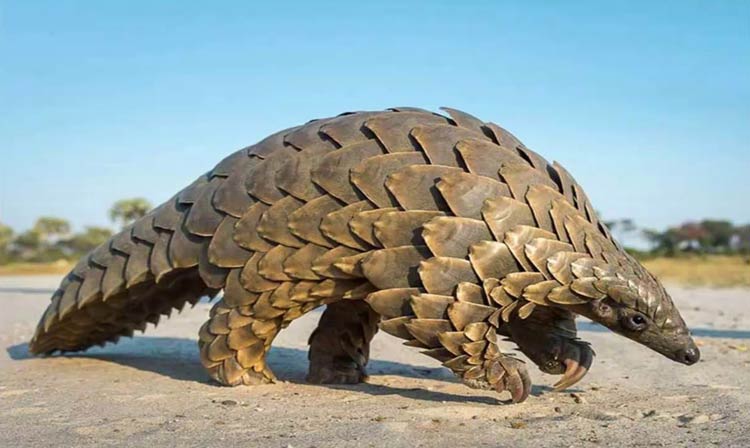
Diet
The pangolin feeds almost exclusively on insects: beetles, termites, ants, and cockroaches. It can also consume larvae, eggs, and worms (e.g., earthworms). To aid digestion, it also ingests sand and clay. Because it does not have teeth, it sometimes swallows stones, which grind food in the stomach, which is surrounded by strong muscles that further facilitate the digestion process (which, in fact, occurs entirely in the stomach).
Acquiring Food
The senses of sight and hearing are weak, but the pangolin manages well with the help of its sense of smell. Thanks to it, it can locate the nests of termites and ants. Once it has done this, its long claws come into action, tasked with digging up even very hard ground. Its thin, long tongue, however, needs only a small opening to “fish” for underground insects. It functions like flypaper, to which ants and termites stick. The pangolin drinks water in a similar way.
The pangolin has a two-chambered stomach: one chamber serves to store food, while the second, constituting 1/5 of the stomach’s volume, is rough and covered with thick muscular tissue. The task of the second chamber is to “break down” and thoroughly digest the food before it reaches the intestines.

Lifestyle
The pangolin leads a nocturnal lifestyle, spending most of its time digging burrows and searching for food. It lives alone for almost the entire year, the exception being the mating season – during this time, the male and female live in the same burrow.
The pangolin creates 2 types of burrows: the first is used for finding food, the second type are homes. Their depth varies depending on the type of soil. In soft ground, the length of the tunnel can reach up to 6 m (approx. 20 ft), but in rocky, hard ground, the pangolin is able to create a burrow with a depth not exceeding 2 m (approx. 6.6 ft). The entrance is usually covered with a thin layer of soil so that predators cannot discover the shelter.
A pangolin uses one residential burrow for several months. After this time, it creates a new one nearby the old one. Often, however, the pangolin moves back into the old nest.
When it feels threatened outside its burrow, it rolls into a ball like a hedgehog. Instead of spines, however, it exposes its broad scales which function as armor. An additional defense mechanism of this mammal is also a foul-smelling, yellowish substance secreted from its anal glands (similar to a skunk or honey badger).
Although it does not live in trees, it can move among them. Its prehensile tail and sharp claws help it greatly in this. This is because many species of ants and other insects found on trees are prey for the pangolin. However, it spends most of its time on the ground, so it is considered a terrestrial animal.
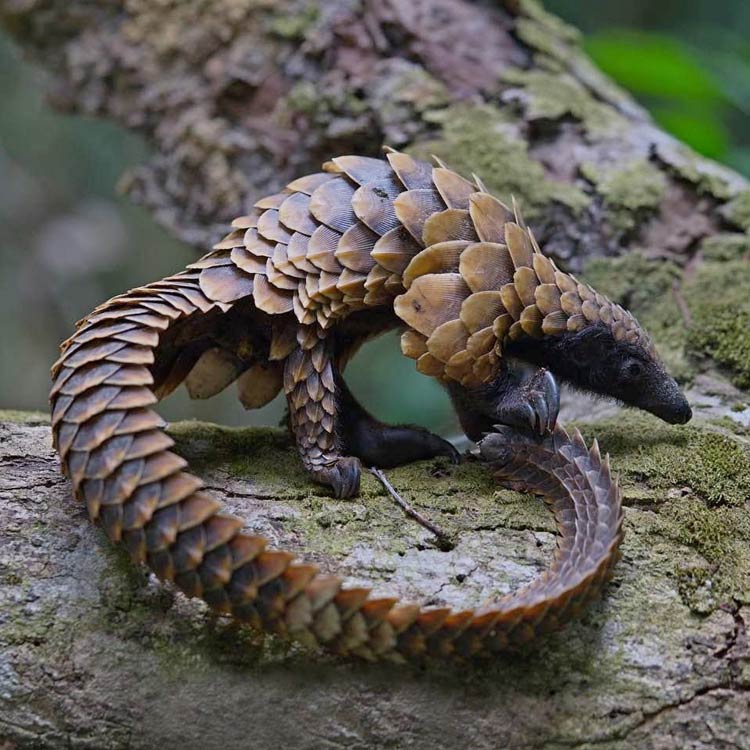
Reproduction
So far, the reproductive habits of the Indian Pangolin are only superficially known. It is known that males and females may live in the same burrow during the mating season, gestation lasts 65-70 days, and the female usually gives birth to 1 young at a time (although cases of twins have occurred). Immediately after birth, a young pangolin weighs 235-400 g (8.3-14.1 oz) and measures about 30 cm (approx. 11.8 inches) in length. Newborns have open eyes and soft scales, from between which individual hairs protrude. After birth, the mother carries the young on her tail, although it can move independently from birth. In case of danger, the young hides under the mother’s belly.
It is estimated that most births occur in January, July, and November. After about 1 month, the young stays on the upper side of the mother’s tail while she is foraging. After about 3 months, the infant is weaned.
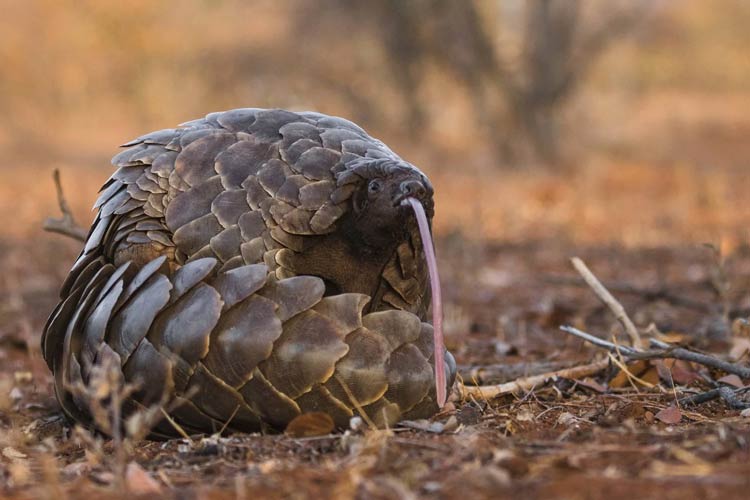
Illegal Pangolin Trade
The demand for pangolins fuels a vast and destructive illegal wildlife trade, making them the most trafficked mammals globally. This illicit trade is primarily driven by two main factors: their meat, considered a delicacy and a symbol of status in certain Asian cultures, and their scales, which are wrongly believed to possess medicinal properties in traditional Asian medicine systems. These uses are not supported by scientific evidence.
Pangolins are trafficked in various forms: as live animals, frozen carcasses, or separated scales. The trade networks often span continents, moving pangolins from their native habitats in Africa and Asia to primary consumer markets, particularly in China and Vietnam. The sheer volume of this trade has pushed all eight pangolin species to the brink of extinction, underscoring the urgent need for international cooperation and heightened enforcement efforts to dismantle these criminal networks.
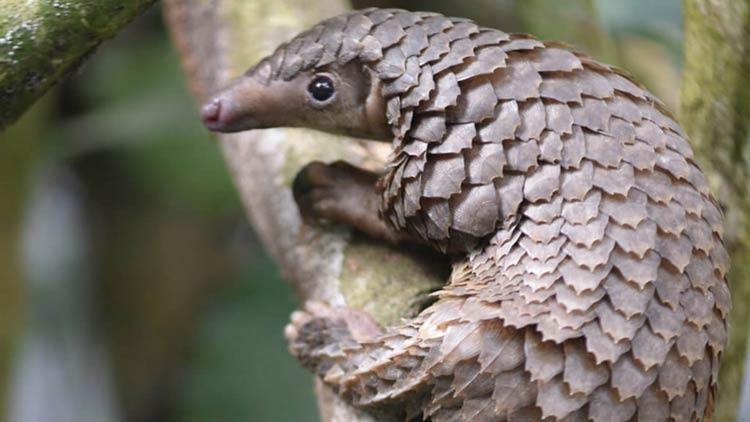
Pangolins and the Novel Coronavirus (2019-nCoV)
The deadly coronavirus epidemic in China may have spread from bats to humans through the illegal trade and smuggling of pangolins, the world’s only mammals covered in scales. They are valued in Asia as a delicacy and used in Chinese medicine.
“This discovery will be of great significance for the prevention and control of the virus’s origin“, stated scientists from South China Agricultural University, which led the research in this area.
Conservation Status and Threats
All eight species of pangolins are currently listed as threatened on the IUCN Red List of Threatened Species, with four species (Chinese, Sunda, Philippine, and Indian Pangolins) classified as Critically Endangered, and the other four African species (Tree, Long-tailed, Giant, and Ground Pangolins) as Vulnerable or Endangered. This makes them one of the most trafficked mammals in the world.
The primary threat to pangolins is poaching driven by the illegal wildlife trade. Their meat is considered a delicacy in parts of Asia, particularly China and Vietnam, while their scales are highly sought after for use in traditional medicine, despite having no scientifically proven medicinal value. It is estimated that over a million pangolins have been trafficked globally in the last decade, leading to drastic population declines.
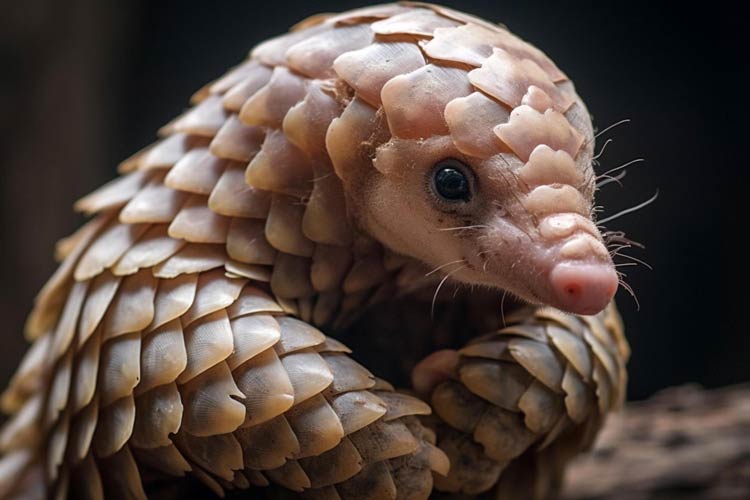
Detailed Data / Dimensions
Indian Pangolin, thick-tailed pangolin (Manis crassicaudata)
- Body length without tail: 45-75 cm (17.7-29.5 inches)
- Length with tail: 84-122 cm (33.1-48.0 inches)
- Tail length: 33-45 cm (13.0-17.7 inches)
- Weight: 10-16 kg (22.0-35.3 lbs)
- Lifespan: over 19 years in captivity. However, it is not known how long-lived it is in the wild.

Indian Pangolin – Interesting Facts
- Other names for the Indian Pangolin include the thick-tailed pangolin and scaly anteater.
- Scales constitute about 1/4 of the animal’s body mass.
- The Indian Pangolin is hunted for its meat, which many consider tasty. Medicinal oil is also produced from its fat. Scales are used as jewelry, and shoes are made from the skin.
- The pangolin is a very useful animal because it eats termites, which are responsible for destroying crops and buildings.
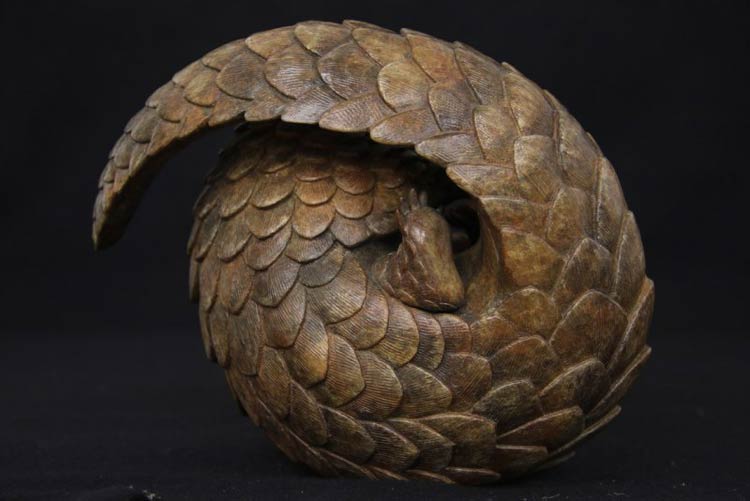
Recommended
- Bengal cat
- Chinese mountain cat
- Leopard cat
- Tiger – the king of the jungle
- Siberian tiger
- Bengal tiger
- Sumatran tiger
- Indochinese tiger
- Malayan tiger
- South China tiger
- Tigers
- White tigers
- Lions
- White lions
- Lion vs tiger
- Liger
- Animal fights
- American lion
- European cave lion
- Smilodon – Saber-toothed tiger
- Fights of animals
- Big cats
- Black panther
- Leopard
- Snow leopard
- African Lion
- Fastest animals
- Fastest birds

